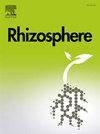Pb pollution altered bacterial community assembly and predicted functions in aggregate-size fractions of agricultural soil near a smelter
IF 3.4
3区 生物学
Q1 PLANT SCIENCES
引用次数: 0
Abstract
In order to investigate the impact of Pb smelter pollution on bacterial community structure, diversity and function at the microenvironment scale, the maize rhizosphere soils subjected to long-term (over 20 years) Pb smelter pollution were collected, and bacterial communities and putative functions in different aggregate-size fractions were identified by 16S rRNA sequencing, KEGG and FAPROTAX. The results showed that Pb pollution significantly diminished bacterial diversity, and prompted a shift in the bacterial communities toward more oligotrophic taxa, including Firmicutes, Chloroflexi, and Gemmatimonadetes. Furthermore, the functional subcategories related to cell motility and energy metabolism, as well as the functional groups involved in carbon (C), nitrogen (N), and sulfur (S) cycles, exhibited a marked decline under Pb pollution. At the aggregate scale, distinct differences were observed in the composition of bacterial communities across silt and clay (<250 μm), micro-aggregates (250–1000 μm), and macro-aggregates (1000–2000 μm and >2000 μm) in uncontaminated soils. However, Pb pollution disrupted these original distinctions among bacterial communities in various aggregate-size fractions, with a decreased abundance of dominant Proteobacteria and an increased abundance of Firmicutes in large aggregates. While the differences in bacterial functional groups in aggregate-size fractions were also detected. The functional groups associated with C and N cycles were significantly enriched in the macro-aggregates (1000–2000 μm) in uncontaminated soils. However, similar with the change of bacterial community structure, most functional groups (except for chemoheterotrophy) in aggregate-size fractions exhibited no significant differences under Pb exposure. Our results suggested that Pb pollution altered bacterial community structure and predicted functions at the aggregate level, and showed greater negative effects on bacterial functions in macro-aggregates (1000–2000 μm). This study can provide a new perspective for the influence of Pb smelter pollution on soil aggregate microenvironment.
铅污染改变了冶炼厂附近农业土壤中聚合体大小部分的细菌群落组合和预测功能
为了在微环境尺度上研究炼铅厂污染对细菌群落结构、多样性和功能的影响,收集了长期(超过20年)受到炼铅厂污染的玉米根瘤土壤,并通过16S rRNA测序、KEGG和FAPROTAX鉴定了不同聚合粒度组分中的细菌群落和推定功能。结果表明,铅污染大大降低了细菌的多样性,并促使细菌群落向低营养类群转变,包括固氮菌属、绿僵菌属和革囊菌属。此外,与细胞运动和能量代谢有关的功能亚类,以及参与碳(C)、氮(N)和硫(S)循环的功能类群,在铅污染下都出现了明显的减少。在未受污染的土壤中,淤泥和粘土(250 微米)、微团聚体(250-1000 微米)和大团聚体(1000-2000 微米和 >2000 微米)的细菌群落组成在团聚体尺度上存在明显差异。然而,铅污染破坏了不同聚集体大小部分细菌群落之间原有的区别,在大聚集体中,优势变形菌的数量减少,而固着菌的数量增加。同时还发现了聚集体大小组分中细菌功能群的差异。在未受污染的土壤中,与碳和氮循环相关的功能群在大聚集体(1000-2000 μm)中明显富集。然而,与细菌群落结构的变化类似,大多数功能群(除趋化异养生物外)在聚合体大小的组分中在铅暴露下没有表现出明显的差异。我们的研究结果表明,铅污染改变了聚合体水平的细菌群落结构和预测功能,并对大聚合体(1000-2000 μm)中的细菌功能产生了更大的负面影响。这项研究为研究铅冶炼厂污染对土壤团聚体微环境的影响提供了一个新的视角。
本文章由计算机程序翻译,如有差异,请以英文原文为准。
求助全文
约1分钟内获得全文
求助全文
来源期刊

Rhizosphere
Agricultural and Biological Sciences-Agronomy and Crop Science
CiteScore
5.70
自引率
8.10%
发文量
155
审稿时长
29 days
期刊介绍:
Rhizosphere aims to advance the frontier of our understanding of plant-soil interactions. Rhizosphere is a multidisciplinary journal that publishes research on the interactions between plant roots, soil organisms, nutrients, and water. Except carbon fixation by photosynthesis, plants obtain all other elements primarily from soil through roots.
We are beginning to understand how communications at the rhizosphere, with soil organisms and other plant species, affect root exudates and nutrient uptake. This rapidly evolving subject utilizes molecular biology and genomic tools, food web or community structure manipulations, high performance liquid chromatography, isotopic analysis, diverse spectroscopic analytics, tomography and other microscopy, complex statistical and modeling tools.
 求助内容:
求助内容: 应助结果提醒方式:
应助结果提醒方式:


